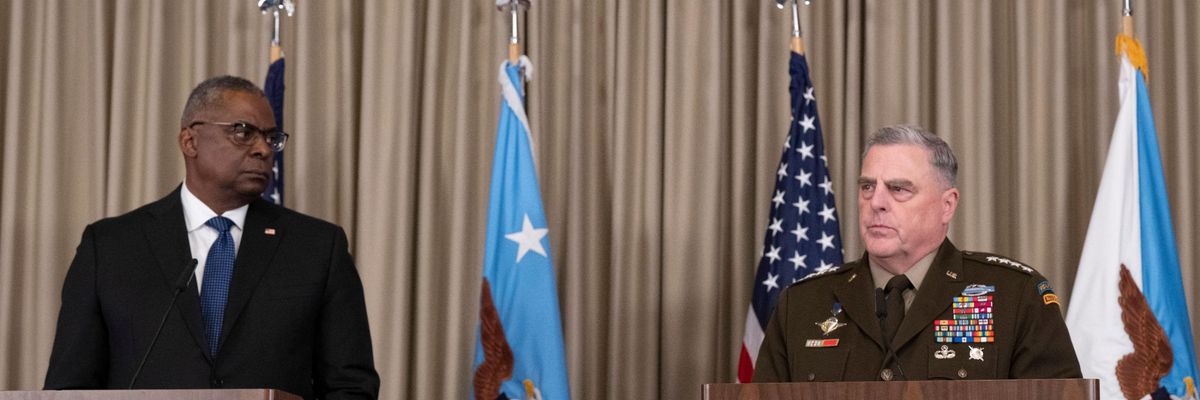While Ukrainian forces continue to make advances against Russian invaders nearly seven months into the war, an expert at Brown University warned Thursday that the United States boosting military spending in response to Russia could lead to a nuclear confrontation.
"If the U.S. and NATO increase their military spending and conventional forces in Europe, the weakness of Russian conventional military forces could prompt Moscow to rely more heavily on its nuclear forces."
Visiting professor Lyle Goldstein authored a report--titled Threat Inflation, Russian Military Weakness, and the Resulting Nuclear Paradox: Implications of the War in Ukraine for U.S. Military Spending--for the Costs of War Project at Brown's Watson Institute for International and Public Affairs.
"Russian aggression in Ukraine requires an international response. However, it does not justify increased U.S. military budgets, which could ultimately escalate tensions with Russia and once again lead us down a dangerous path," said Costs of War Project co-director Stephanie Savell in a statement.
Given that the United States and other NATO nations are pouring money into Ukraine and Russia and the U.S. have by far the largest stockpiles of nuclear weapons, concerns have mounted since February that the regional war could lead to global catastrophe.
"The U.S. military budget is poised to surge above $800 billion, in part due to the conflict in Ukraine. But higher spending isn't the solution," said Savell. "This research lays the foundation for a more honest conversation in the U.S. about what's truly going to promote peace for people in the region, and for the world."
Goldstein's paper explains that "historically, threat inflation has led to disastrous and unnecessarily costly U.S. foreign policy decisions," and "Western strategists have a long tradition of overinflating Russia as a threat."
"Major examples would, of course, include the famous 'missile gap' that turned out to be completely backwards, when in fact the U.S. had a vastly larger nuclear arsenal compared to the USSR in the early 1960s," the report notes. "The false perception of a gap helped to prompt an arms race that resulted in wasteful and dangerous arsenals of tens of thousands of nuclear weapons on both sides."
Recalling the closest the United States and the Soviet Union ever came to nuclear war, Goldstein said in a statement Thursday that "as we approach this 60th anniversary of the Cuban Missile Crisis, it is imperative to mitigate Cold War-type tensions with Moscow and prioritize reducing nuclear risk."
Reducing that risk requires recognizing that, as the report says, "Russia is a weaker conventional military power than many in the U.S. had imagined; thus, there is no additional cause for intensified fear of a Russian military threat to the U.S. nor for the resultant expansion of the Pentagon budget."
"On the other hand," the document cautions, "if the U.S. and NATO increase their military spending and conventional forces in Europe, the weakness of Russian conventional military forces could prompt Moscow to rely more heavily on its nuclear forces."
Goldstein is an expert in Russian military strategic development who spent two decades on the faculty at the U.S. Naval War College. For this report, he incorporated Russian-language sources, which provided a "deeper, insider's view" of the military's "multifarious, endemic problems."
Due to its relatively low military spending, "Russia doesn't seem to have a military that is capable of protracted, large-scale offensive action, let alone expeditionary operations, that could threaten U.S. national security," the paper says, detailing poor performances by Russian aerial, cyber, ground, missile, naval, and space forces against Ukraine this year.
"Contrary to conventional wisdom, the U.S. defense budget does not need to continue to grow," the paper emphasizes. "Rather, cognizant of Russia's conventional military weakness, the U.S. military budget can instead be trimmed."
Along with the nuclear risk argument, the paper points to developments in Europe to make a case for reducing U.S. military spending.
"Russian armies are completely unable to march on Paris or Berlin, let alone Warsaw or Bucharest now or in the foreseeable future. It is plain enough that they could not even conquer Kyiv," the document states. "Yet, the horrors of Kremlin aggression, which cannot be minimized, have also galvanized a new effort by Europeans to take their security into their own hands."
"The presently developing situation, in which Europeans spend more on defense, may reflect a more rational re-balancing of defense burdens, enabling the U.S. to demilitarize, at least in some degree," the report asserts, while also highlighting that "the most promising negotiations on Ukraine prior to the war were spearheaded by European leaders."
According to Goldstein:
While not successful ultimately, the format had very substantial promise to make a breakthrough. Thus, an energized European defense will hopefully herald more fair Trans-Atlantic burden-sharing, but may also hopefully usher in an era of more responsible, mature, realistic, and inclusive policies for European security. In that way, the militarized approach to Russia, inevitable in the short term, can gradually give way to a return to diplomacy and peace over time. By increasing the European content of European security, better outcomes may result, since the U.S.-and-NATO-dominant architecture has generally failed to produce a lasting peace in contemporary Eastern Europe.
To end Russia's war in Ukraine, the paper suggests pursuing "de-escalatory approaches," including "direct talks, reviving the arms control agenda, and pursuing military confidence-building measures between NATO countries and Russia."
The report comes as anti-war groups--including CodePink--engage in a week of action across the United States to push for peace in Ukraine.
"The White House and Congress are fueling this war with a steady stream of weapons instead of pushing for talks to end the conflict," said CodePink co-founder Medea Benjamin. "That's why we, the people, have to rise up with a demand of negotiations, not escalation."

